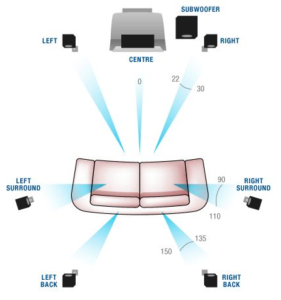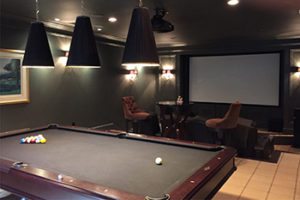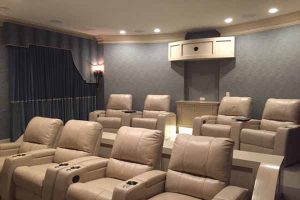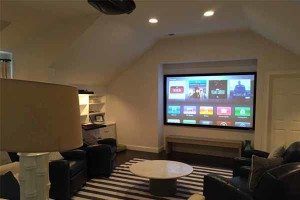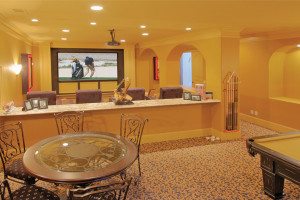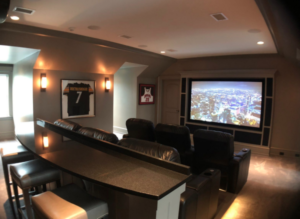The prevalence of theater rooms has become a classic trend we have seen in homes. We are ecstatic to work with clients that have a vision of a flawless theater experience. Whether they have the exact layout or need some guidance, we love coming up with the best solutions that fit each unique clients’ home. One of the great things about the implementation of these theater rooms is that they look like a real-life theater! Maybe a few years back, a home theater room consisted of an average size flat screen TV with a singular couch in the center of the room; no speakers, no subs, nothing. The theater rooms we have completed are completely elevated and take you on an immersive experience. If you’re more of a homebody like me and enjoy the company of family and friends, having a home theater totally makes sense. No more getting crammed in a stuffy crowded theater or sitting in front of a toddler that won’t stop kicking your seat. No more having to sneak in candy at the movie theaters, you’ll be able to snack freely in the comfort of your own theater room. So if you’re looking to add a home theater or media room into your home, but don’t know where to begin, here are a few tips to get you started on your project.
Measure the Size of the Room
This is extremely important; before you even begin your project, take time to measure the room! Finding the most optimal layout to crucial for the placement of equipment throughout the room. Don’t forget that measuring the height of the room is important when it comes to your mounting your projector or TV. They say that the optimal viewing angle is about 30 to 40 degrees. You want to make sure that you are viewing from eye level and not having to jerk your head at an angle to watch a movie. Finding the best parts of the room to place your speakers can make or break the experience we were talking about. You want guests and residents to be completely enveloped into the ultimate theater experience, and having bad placement of speakers throughout the room can detract from that.
This is the most optimal layout for a 5.1 speaker system. As you can see, there are specific angles that you should place the speakers in contrast to the rest of the furniture in the room. This would be a typical layout for a square-shaped room. We know that every client has different room sizes and layouts, so it is best to do research on finding the best setup for your room shape before starting as there are many different surround sound layouts to choose from.
Typical 5.1 surround sound layout
Equipment Preference
The next important step to your project is choosing your equipment. Flat screen or projector? 5.1 Speaker system or 7.1 Speaker System? Standup or hidden speakers? This may be a lot to answer, but it is your preference for the mood or atmosphere you are going for. Some of our clients want to the absence of any equipment in the room, so they opt for hidden speakers and projector screens. This is a great solution for smaller rooms; hiding the equipment really opens up the room and wraps you into that theater experience. Some of our clients have a larger space, so the presence of equipment does not bother them.
Design and Aesthetics
Now we get the fun part, coming up with the design you want for the room. If you’re at a loss and don’t know the look you want to go for, I suggest surfing the web and saving pictures that you feel inspired by. If you have windows in the room, it is important to install some blackout curtains or shades. Lutron has a great selection of dual-sided motorized shades that double up as blackout shades so you won’t have to compensate for design. The shades can even act as additional barriers so sounds don’t bounce off the windows. If you’re starting from scratch and want to go all out, you can additionally think about flooring, seating, furniture, wall color, and finishes. Many of the theater rooms we have worked on have reclined seating to add extra comfort and angle viewing preference.
Keeping Everything Organized
Now that you have picked out your equipment and are getting ready to set it up, keep in mind that there’s going to be a decent amount of wiring. Make sure you keep it organized in the case of troubleshooting and detecting which wire you’ll need for future issues. Plastic ties are a great way to group together your wires instead of having a tangled and intertwined mess. Color coding and labeling important wires is another great way to save you time and energy in the future. Another great tip is to document any connections to the power in case you have to reset or reboot the system.
For more information on Home Theaters and Media Rooms
https://hiltonheadhometheater.com/services/home-theater/
By Wendy Wang

